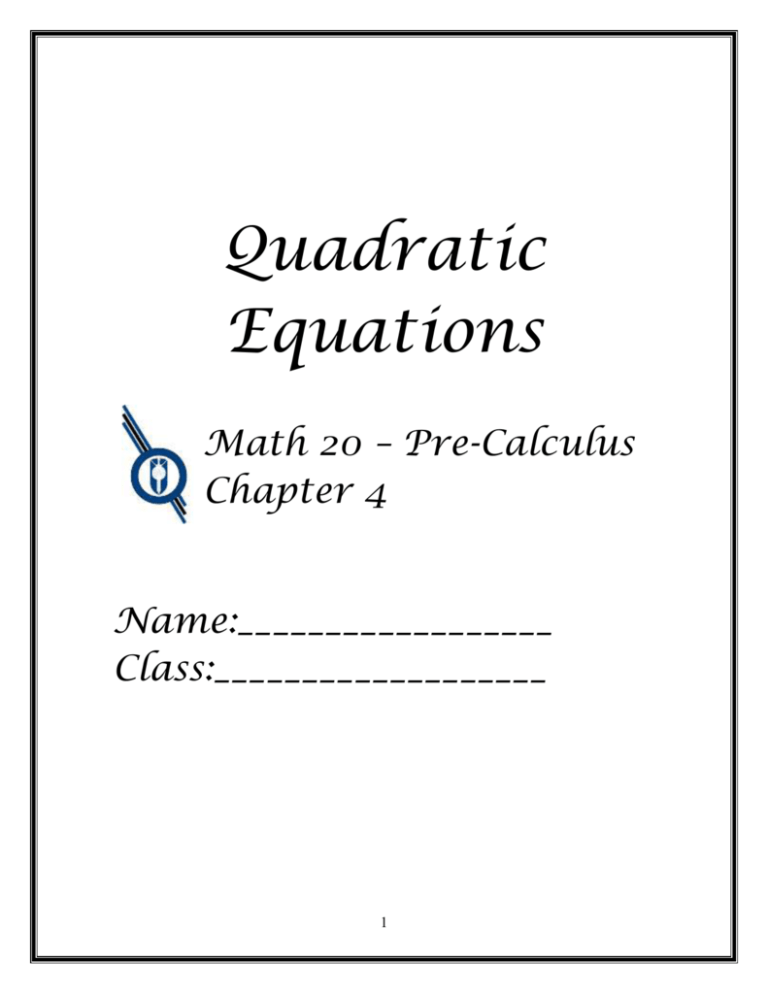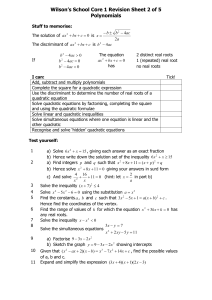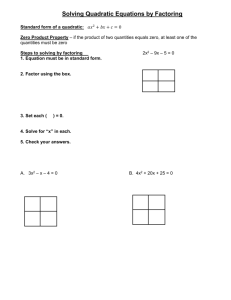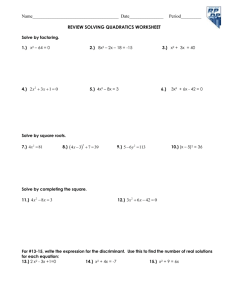Quadratic Equation Notes
advertisement

Quadratic Equations Math 20 – Pre-Calculus Chapter 4 Name:__________________ Class:___________________ 1 Relations and Functions Specific Outcomes 5. Solve problems that involve quadratic equations. General Outcome: Develop algebraic and graphical reasoning through the study of relations Achievement Indicators: The following set of indicators may be used to determine whether students have met the corresponding specific outcome 5.1 Explain, using examples, the relationship among the roots of a quadratic equation, the zeros of the corresponding quadratic function and the x-intercepts of the graph of the quadratic function. 5.2 Derive the quadratic formula, using deductive reasoning. 5.3 5.4 5.5 5.6 5.7 Solve a quadratic equation of the form ax bx c 0 by using strategies such as: Determining the square roots Factoring Completing the square Applying the quadratic formula Graphing its corresponding function Select a method for solving a quadratic equation, justify the choice, and verify the solution. Explain, using examples, how the discriminant may be used to determine whether a quadratic equation has two, one or no real roots; and relate the number of zeros to the graph of the corresponding quadratic function. Identify and correct errors in a solution to a quadratic equation. Solve a problem by: Analyzing a quadratic equation Determining and analyzing a quadratic equation. 2 Big Ideas: Students will understand … Information from quadratic equations and the graphs of quadratic functions can be used to solve problems in areas like physics, calculus, engineering, architecture, sports and business. By the end of the unit students should: The basic shape and characteristics of the graph of a quadratic function. Quadratic functions and equations relate to real life situations. Solving an equation means to find the root(s). 2 4.1 Graphical Solutions of Quadratic Equations Part A: Graphically Solutions Recall from Chapter 3 A quadratic function is … A quadratic equation is … Root(s) of an equation… Zeros(s) of a function … The strategies that we will learn to solve a quadratic equation are: - Graphing it’s corresponding function - Factoring - Completing the square - The Quadratic Formula Example: Graph each of quadratic function and determine the x-intercepts y x2 8x 5 y 2 x 2 12 x 10 3 Example: Solve each of the quadratic equation by using a graphical approach a) 4 x 2 12 x 1 0 b) x 2 x 0 Summary Types of Quadratic Functions 4 c) 3x 2 10 x 9 0 Part B: Applying Graphically Solutions to Problems How do I approach a “word” problem? Example: The height, h, in meters above the ground, of a ball being thrown off a roof at time, t after the launch is defined by the function h(t ) 4t 2 48t 3 . a) Sketch the important part of the parabola. b) Find the maximum height reached by the ball. How long does it take the ball to reach it’s maximum height? c) How long does it take for the ball to hit the ground? d) How high is the roof? e) Find the height of the ball after 3 seconds. Homework Textbook Page 215 #1 - 6, 9, 10 5 4.2 Factoring Quadratic Equations Part I: Review of Factoring Recall from Math 10 – C Key Ideas regarding factoring Example: Factor each of the following a. y 2 8 y 15 b. 12 x 2 2 x 30 c. 4t 2 16t 48 d. 4 x 2 12 x 9 e. 25m2 36 f. 8x 50 xy 2 g. ( x 5)2 4( x 5) 21 3 h. 4( y 2)2 36( x 3) 2 Homework Textbook Page 229 #1-6 6 4.2 Factoring Quadratic Equations Part II: Solving Quadratic Equations by Factoring Recall: If (A)(B) = 0, then either A = 0 or B = 0 What is the difference between factoring and solving an equation? Example: Solve each of the following quadratic equations by factoring. a. x 2 3x 2 0 2 b. x 8x 15 0 c. 3x 2 14 x 5 0 2 d. 2 x 24 x 54 0 e. x 2 64 0 f. x 2 10 x 16 g. x 2 9 x 0 h. 25 x 2 49 0 i. Homework Textbook Page 230 #7-10, 12, 13 7 1 2 x 5 x 18 3 4.3 Solving Quadratic Equations by Completing the Square Recall from Chapter 3 Recall: Perfect Square Trinomials (a b)2 a 2 2ab b2 Indicate the constant that must be added so that the trinomial is a perfect square and then factor the trinomial. a. x2 + 14x + b. x2 – 20x + Convert each of the following functions into vertex form a. y x 2 18 x 32 b. y x 2 8t 4 Example: Solve each quadratic equation by completing the square. a. x 2 10 x 23 0 b. a 2 6a 7 0 c. 2 x 2 12 x 11 0 Homework Textbook Page 240 #1, 3, 6 8 4.4 The Quadratic Formula Part I: The Quadratic Formula Complete the square to solve this quadratic equation: (b and c are constants) ax 2 bx c 0 The roots(solutions) of the quadratic equation ax 2 bx c 0 can be found using the Quadratic Formula: x b b 2 4ac 2a 9 Example: Use the quadratic formula to solve each of the following quadratic equations. a. 3x 2 5x 11 0 a= b= b. 2t 2 11t 13 0 c. x 2 6x 7 0 c= Example: The height of the Peace Tower in Ottawa is 90 m. If an object is thrown downward at 5 m/s from this height, the time, t seconds, the object takes to reach the ground can be found by solving the equation –4.9t2-5t + 90 = 0. Find the time, to the nearest tenth of a second, for the object to hit the ground? Homework Textbook Page 254 #3, 4, 5 10 4.4 The Quadratic Formula Part II: The Discriminant Graph each of the following quadratic equations and use the quadratic formula to determine the roots of each function. x2 2x 3 0 x2 2 x 1 0 x2 2x 3 0 If you examine the expression, b 2 4ac , in the quadratic formula the result will help us determine the roots. b 2 4ac is called the discriminant of the quadratic equation because it discriminates among the types of possible solutions. Number of Roots of a Quadratic Equation: The quadratic equation ax 2 bx c 0 has: two real roots when b 2 4ac 0 exactly one real root when b 2 4ac 0 no real roots when b 2 4ac 0 11 Example: Use the discriminant to determine the number of roots for each. Use technology to check your answers graphically. a. 16 x 2 8 x 1 0 b. 3 x 2 6 x 3 0 c. 2 x 2 7 x 9 0 Nature of the Roots Example Determine the value of “m” that will give the quadratic: 3x 2 4 x m 0 a. two equal roots (1 real root) b. no real roots mx 2 8 x 3 0 a. two distinct real roots Homework Textbook Page 254 #1, 2 12








